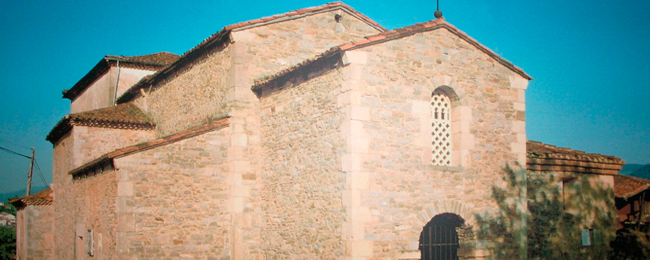In Oviedo
Santianes de Pravia
From the information contained in the Codex Albeldensis it appears that this temple was built by King Silo and his wife Adosinda between 774 and 783 "when it established the court in Pravia". Conceived as a palatine church or royal chapel with royal pantheon functions, it was founded in dedication to Saints John the Apostle and Evangelist, Peter, Paul and Andrew, and would have been situated close to the King´s palace complex, although its original location has still not been identified. Upon the death of King Silo in 774, both the palace complex and church were converted into a monastic residence where Queen Adosinda retired on 26 November 785. According to the Chronicle of Alfonso III in the year 905, Silo was buried in the portico of the Santianes temple, thus turning it into a royal pantheon in accordance with Hispanic tradition.
The original condition of the church has come down to us thanks to the descriptions of various authors, among these Ambrosio de Morales (1513-1591), Tirso de Avilés (1516-1599) and Luis Alfonso de Carvallo (1571-1635). These testimonies are prior to the reforms carried out by Fernando de Salas in 1637, a time when the church underwent substantial changes to the original, pre-Romanesque architectural structure. The creation of a burial ground inside the church for the Salas family involved the demolition and expansion of the main chapel, as well as the breaking and dispersal of the famous acrostic Silo princeps fecit, a foundational inscribed tombstone of the church.
In 1894 important architectural remains belonging to the original pre-Romanesque basilica were discovered: a pilaster, probably the altar podium, and two inner doors with dimensions of approximately 1 metre tall by 0.5 metres wide, adorned with different floral and geometric motifs. The collection of pieces were transferred to the Jesús Nazareno chapel in El Pitu (Cudillero).
During the excavation and restoration work beginning in 1975, managed by José Menéndez Pidal, a basilica floor was found with a central nave of 8 metres long and 5.5 metres wide, separated from the side naves of 2.5 metres tall using arches made up of three rounded arches resting on pillars. The temple has a 4.5 metre wide transept divided into three sections reflecting the naves, the arches continuing until they meet the alter end of the nave through diaphragm arches.
The alter end of the nave opens towards the east and is comprised of a single apse with a semi-circular stilted arch at an axis with the central nave. The size of its internal diameter is 4.5 metres and it would have been covered by a calotte dome. On the exterior, the apse was quadrangular and there were no side apses. Much of the presbytery paving has been preserved. This is made up of opus signinum which gives it a high quality and unique richness.
To the west we see the entrance hall, free-standing, over which is a platform introduced in modern times, which originally would have been built when the hall or portico became a royal burial site. This would have been accessed by an interior staircase, made of wood. The entrance to the hall from outside the temple did not have a closing door, while communication between this and the central nave was through lintel openings of a height of 1.05 metres. The building´s exterior uses the bonding of masonry or ashlar stones. The corners have generally well squared ashlar stones that were set in place with ropes and logs. As we can see, the San Juan Evangelista basilica in Santianes de Pravia has some structural characteristics that largely foreshadow the subsequent Asturian pre-Romanesque architecture.
Important information
Location
Santianes de Pravia
Visits
Arrange a visit at the Pravia Tourist Office or by calling 985 82 12 04.
Closed on Mondays.
Comments
Prices:
General: 3,5 €.
Children from 12 to 16 years old: 1,70 €.
Children under 12 years old: free entry.
Groups over 15 adults: 1,70 €.
Groups over 15 children: 1,10 €.












